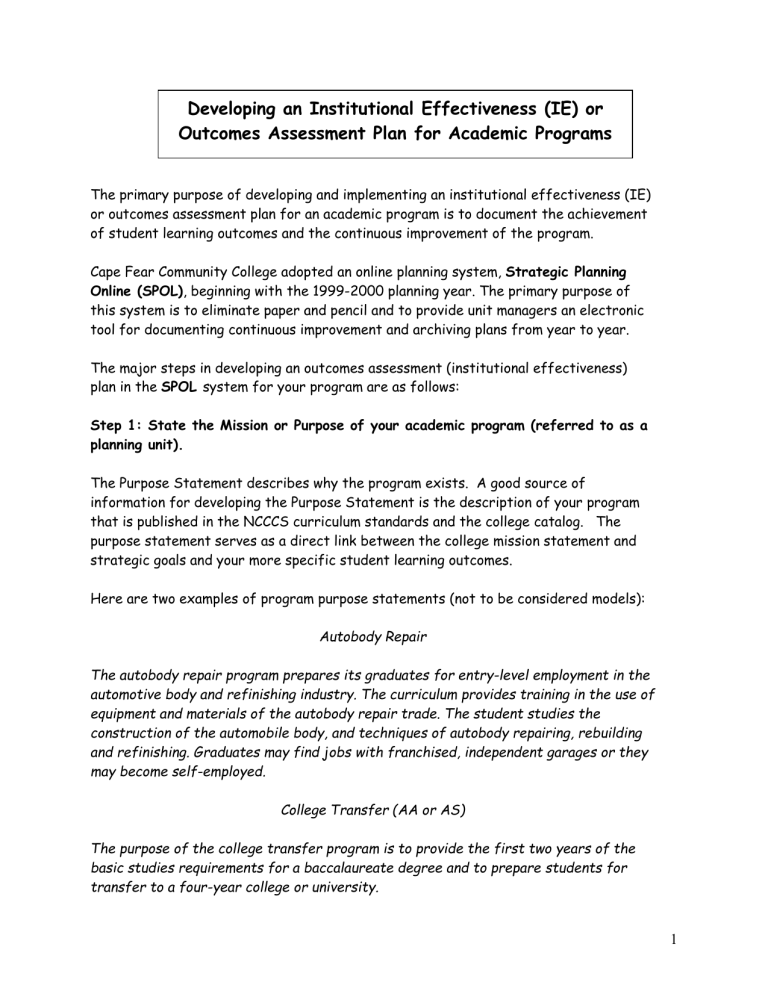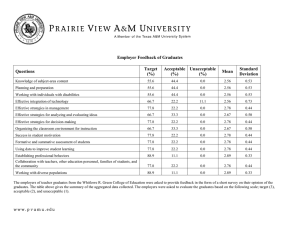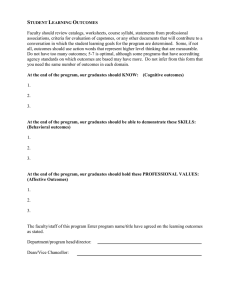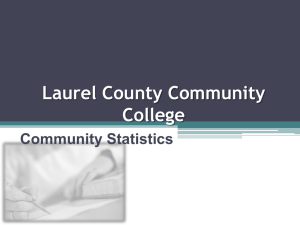Developing an Institutional Effectiveness (IE) or

Developing an Institutional Effectiveness (IE) or
Outcomes Assessment Plan for Academic Programs
The primary purpose of developing and implementing an institutional effectiveness (IE) or outcomes assessment plan for an academic program is to document the achievement of student learning outcomes and the continuous improvement of the program.
Cape Fear Community College adopted an online planning system, Strategic Planning
Online (SPOL), beginning with the 1999-2000 planning year. The primary purpose of this system is to eliminate paper and pencil and to provide unit managers an electronic tool for documenting continuous improvement and archiving plans from year to year.
The major steps in developing an outcomes assessment (institutional effectiveness) plan in the SPOL system for your program are as follows:
Step 1: State the Mission or Purpose of your academic program (referred to as a
planning unit).
The Purpose Statement describes why the program exists. A good source of information for developing the Purpose Statement is the description of your program that is published in the NCCCS curriculum standards and the college catalog. The purpose statement serves as a direct link between the college mission statement and strategic goals and your more specific student learning outcomes.
Here are two examples of program purpose statements (not to be considered models):
Autobody Repair
The autobody repair program prepares its graduates for entry-level employment in the automotive body and refinishing industry. The curriculum provides training in the use of equipment and materials of the autobody repair trade. The student studies the construction of the automobile body, and techniques of autobody repairing, rebuilding and refinishing. Graduates may find jobs with franchised, independent garages or they may become self-employed.
College Transfer (AA or AS)
The purpose of the college transfer program is to provide the first two years of the basic studies requirements for a baccalaureate degree and to prepare students for transfer to a four-year college or university.
1
Step 2: Write objectives / expected student outcomes for your program
Student learning outcomes are specific statements describing what students should know (cognitive), think (attitudinal) or do (behavioral) when they have completed a program. Peter Ewell, a well-known national assessment expert and researcher, puts it this way:
“A student learning outcome...is…defined in terms of the particular levels of knowledge, skills and abilities that a student has attained at the end (or as a result) of his/her engagement in a particular set of collegiate experiences.”
Developing your program outcomes is the most important step in outcomes assessment planning. Each academic program is expected to assess and document from three to five 5 expected student learning outcomes annually. The aim is to develop purposeful, substantive outcomes. Limiting the number of outcomes makes assessment more manageable.
Examples of types of student learning outcomes are:
Cognitive:
Student knowledge of content specific to the major or the discipline
Knowledge of content in the liberal arts
Competencies attained in the General Education core requirements, i.e. oral and written communications, mathematics, critical thinking, problem solving, computer literacy
Behavioral Change and Performance:
hands-on skills required for effective practice in the major or for employment
interpersonal skills
listening skills
teamwork, leadership skills
on-the-job performance; perceptions of employers or internship supervisors
College transfer success; further education
community contributions, professional activities
job placement
student persistence, completion
Attitudinal :
current students’, graduates’, and early leavers’ satisfaction with their program, the college, support services, learning resources, educational experiences, etc.
employers’ attitudes and opinions about program graduates
student changes/gains in personal, social or ethical attitudes and values
2
One way to select your Student Learning Outcomes:
A very good method for developing specific program outcomes is for the lead instructor and all other faculty teaching in the program to meet and prepare a ‘long list’ of the skills, knowledge and attitudes that all graduates of that program are expected to achieve. Using this long list, faculty can select from 3 to 5 of the learning outcomes from the list each year to include in their annual assessment plan.
Some good sources to review for developing the ‘long list’ of expected learning outcomes for your program’s graduates are:
The minimum skills and competencies required for entry-level employment in a field as identified by employers, advisory committee members or from occupational standards.
Criteria and student competencies set forth by accreditation, licensing and
certification boards or agencies for occupations such as nursing, radiography, pharmacy technology, real estate, accounting, cosmetology, welding, automotive, construction, truck driving and many other CFCC programs.
Course syllabi
Faculty group discussion and input
North Carolina Community College’s curriculum standards by program
Step 3: Establish “Procedures / Assessment Methods” for each learning outcome
After developing your expected student learning outcomes, ask yourself how you will collect evidence to prove students have the skills, knowledge and attitudes you have listed. Ask yourself what sources of information would provide you with data you need for determining student success? It is best to have more than one source of information to determine success. Remember not to use individual student grades as a method for measuring success but instead, you may use aggregate or group performance. Evaluations by an outside third party such as advisory committee members, a panel of faculty, criteria established by accreditation or licensing agencies or other experts in the field are all excellent procedures or assessment methods.
Here are a few examples of appropriate assessment methods that could be used for collecting data:
Use of tests and exams locally or commercially produced to collect group performance
Comparison of student performance against criteria established by accreditation, certification or licensing boards or agencies
Student portfolios of work sampled and collected over time
3
Pre-test and post-test comparisons of group performance
Student juried exhibitions of work, products
Clinical evaluations
Products such as papers or oral presentations judged by peers, experts
Observations of students in case studies or problem-solving situations
Students’ demonstration of hands-on skills
public performances
use of standardized exams for comparison of norms
licensure and certification exam group results
supported opinions of external or third party evaluators
Use of surveys or interviews of graduates, current students and early leavers
Use of survey or interviews of employers about learning demonstrated on the job or during Co-op experience
College transfer student performance reports
Graduate employment data
Advisory committee opinions of the program and student performance
Step 4: Establish the “Criteria for Success”
The ‘Criteria for Success’ is very important because it will be the target or the level of achievement you will use to determine student success.
The faculty should collectively decide the ‘criteria for success’ or targets for achievement. In doing this, you should think about the level students “ought” to perform or the “ideal state” rather than a modest target that you know can be achieved and is ”safe” to assess. Using assessment data to improve a program is greatly diminished when the criteria for success is not set at the level students “ought” to be achieving.
Here are just a few examples of “success criteria” and ‘methods of assessment’ for illustration. The ‘success criteria’ is underlined and the “method of assessment’ (source of the data) is in bold.
95 percent of the graduates in automotive technology will be able to successfully demonstrate all the skills outlined in the NESA certification manual that are required for certification by NESA
95 percent of students taking the licensure exam for Nursing will pass on first sitting.
80 percent of accounting program graduates, as judged by a jury of faculty from the department, will successfully complete a major accounting project utilizing microcomputer applications during one of several classes their last
semester.
4
85 percent of computer engineering graduates will agree or strongly agree with the statement on the Graduating Student Opinion Survey “ The technology used in my program was up-to-date with technology in the computer engineering field.”
85 percent of the college transfer students will have a GAP of 2.0 or greater the two semesters following transfer to a UNC 4-year institution as indicted on the annual Transfer Student Performance Report.
50 percent of the welding graduates will report employment in field on the
Graduating Student Opinion Survey administered at the time of program completion.
80 percent of writing samples selected at the end of English 202 will pass the
faculty written standards rubrics. No single rubric will exhibit more than ¼ of the students’ ratings of “needs improvement” or “unsatisfactory”.
At the close of their final semester, 90 percent of the automotive students will correctly diagnose and estimate the cost of repairs needed on an automobile as assigned within a given period of time and evaluated by a panel of automotive of faculty.
90 percent of the Early Leavers surveyed will report reasons other than dissatisfaction with the college or their program as cause for withdrawing from the college as indicated on their withdrawal form.
A panel of reviewers will confirm that 90 percent of the student portfolios reflect the progressive development of critical thinking skills over time in the program.
95 percent of employers of the Business Administration graduates will indicate on the
Employer Survey that they are ‘satisfied’ or ‘very satisfied’ with graduates’ job performance and would hire them again.
Step 5 – Identify Other “Units Impacted”
Very often you will need the assistance of another department to fully carry out your objective/outcome. It might be that several different departments will be called upon to help you with different tasks. In these instances, your objective/outcome is going to have an impact on the resources of another planning unit. You are asked to indicate which planning unit(s) your objective/outcome will impact so that the unit manager(s) can plan accordingly.
Step 6: Conduct Assessment Activities/Implement your Assessment Plan
Put your assessment plan into action and begin collecting data. Determine which activities are to be conducted at the college level (such as surveys) and those to be carried out by you or others in your program. If you are using college surveys, check
5
with the Research Office to be make sure the questions relate directly to your learning outcomes so you will get back useful information. The Graduating Student
Opinion Survey and the Currently Enrolled Student Survey are two surveys that might help you.
Step 7: Report and Analyze Your Assessment “Results”
The next step is to summarize and report your findings and what happened. How did your students do? Summarize the information and be sure what you report relates directly to your expected outcomes. Your summary should be complete enough to convince the reader that assessment took place. File your more detailed documentation such as copies of surveys, skill check sheets, examples of student work, rubrics, etc. for reviewing progress over time and for future peer review accreditation visits.
Analyze your results. What did your results tell you? How did the students do compared to the level of achievement you expected? Is further assessment needed?
What changes, improvements or modifications will you make or have you already made that will help improve student performance, especially if achievement fell below the expected level? What future action should be taken?
Step 8: “Close the Loop” by documenting the “Use of Results for the
Improvement” of your program
By the time you have progressed to this step, you will have evidence in hand about your program that is important to you. To have a process that is of value, your evidence should be put to good use. Remember, the purpose of assessment planning is to improve, inform, and to prove.
This step is called “closing the loop” because it is the final step in the annual planning
‘cycle’ or “loop”. In this step you are documenting that continuous improvement is taking place in your program. This step is accomplished by reporting any action, change, or improvement made as a result of how well your students performed compared to what was expected of them. Here are a few examples of some typical changes or improvements one might see in an assessment plan:
Teaching a new skill or concept in the curriculum to stay current
Changes in the curriculum or course content
Increasing time devoted to teaching a concept or skill
Changes in teaching methods
Pre-requisite course changes or changes to the program of study
Amending syllabi
6
Implementing advisory committee recommendations
Integrating technology into the curriculum
Raising your ‘criteria for success’ the next planning cycle
Making organizational changes
Changes in advising or support services
Changes to policies or the creation of new ones
Sometimes no action or changes are needed because all the students may have met or exceeded the expected level of achievement. If that were the case, you would report that no changes were needed. You might want to take another look at your success criteria to make sure they were not set too low to guarantee success, set unrealistically high, or set just about right. In all cases, something could be learned from the assessment.
Step 9: Begin the Assessment Planning Cycle Again
At the close of the annual planning cycle, review the learning outcomes on your ‘long list’ and select others to assess during the next cycle. Depending on what happened in the previous cycle, there might be learning outcomes that need to be assessed again the following year.
Please see the examples of academic program assessment plans in Appendix A for illustration.
7



